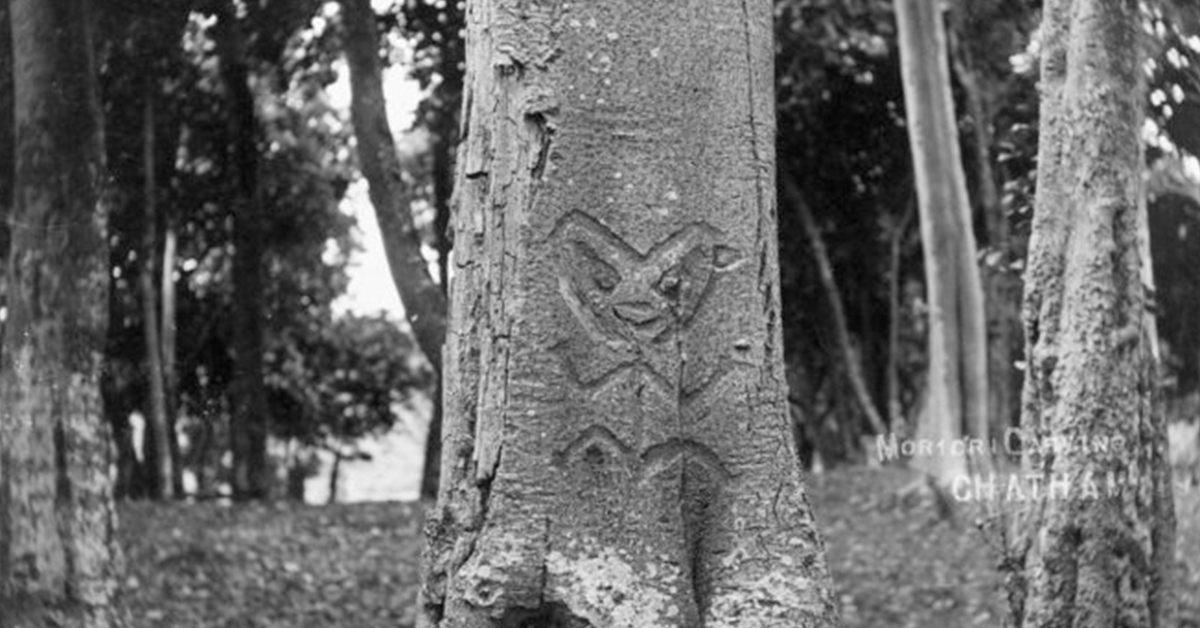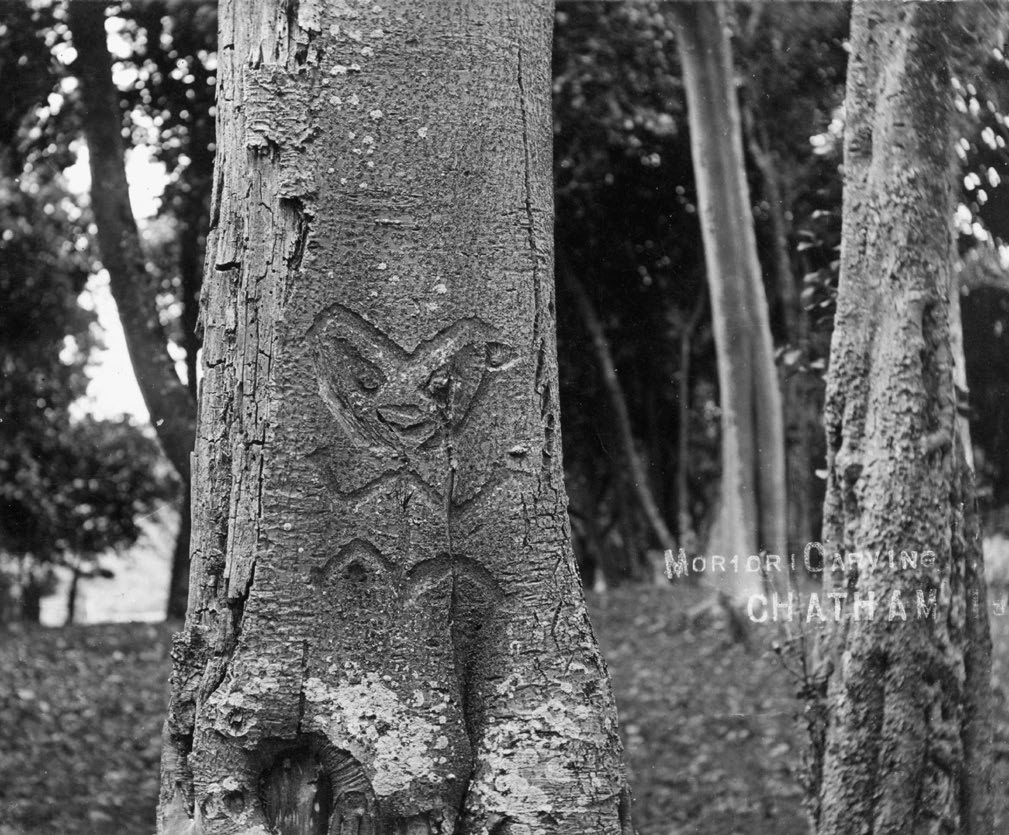
BACKSTORY

Dendroglyph, Chatham Islands. Photo: Kathleen Joan Silcoc, Alexander Turnbull Library.
By Any Other Name
How long has Aotearoa been a name for these islands? The history between Māori and Moriori suggests much longer than some of those objecting to its current use.
By Scott Hamilton
Te Pati Māori (the Māori Party) used this year’s Māori Language Week to renew its call for changing New Zealand’s name to Aotearoa, which it described in a press release as the ancestral name for these islands. Winston Peters was quick to disagree. “‘Aotearoa’ was made up and promoted by colonialists in the late 1800s”, the former deputy prime minister wrote on Twitter.
Many conservative commentators and activists have recycled Peters’ words. But there is an exquisite artefact in the vaults of Waikato Museum that contradicts their polemics. It is a cheque issued by the bank that King Tāwhiao established in the region. Above a delicate portrait of a flax plant, the words “Te Peeke o Aotearoa” (the Bank of Aotearoa) are printed in black. Although the cheque dates from 1905, Tāwhiao established his bank in 1886. Auckland War Memorial Museum holds an older, related artefact. It is a flag that features the name Aotearoa painted on a red backdrop. The flag was captured on 13 December 1863 after a gunfight between colonial Forest Rangers and Waikato warriors in the Hunua Ranges.
Historian Rawiri Taonui has collected still earlier uses. In the 1840s and 50s, Pākehā missionaries and administrators heard Māori in widely separated parts of the country using the name. But could it actually be even older — from the very first settlement of these islands? An unusual source suggests so.
Before I talk about this source, I need to describe something of the history of the Moriori people. Moriori are the indigenous inhabitants of Chatham and Pitt islands, which they call Rēkohu and Rangihaute. They are a Polynesian people, related to Māori but with a unique culture and language. Moriori oral tradition talks of founding ancestors arriving directly from tropical eastern Polynesia in several migration waves. There is also a tradition that talks about voyaging to a place they called Aote.
There is archaeological evidence for the claim of a direct journey from the tropics: two stone pendants found on Rēkohu feature tiny carvings of a bird suspended by its legs. The same image is found in inverted form on many Moriori tree carvings. The suspended bird motif is unknown in Te Ika a Māui and Te Wai Pounamu (the North and South Islands), but common in the jewellery of the Cook and Austral Islands. On the other hand, obsidian from Tuhua Island in the Bay of Plenty has been found throughout Rēkohu, testifying to links with Te Ika a Māui. It’s thought that contact between Māori and Moriori stopped by about AD1550, as Moriori culture shows no sign of features of more recent, “classical”, Māori culture, like the hei tiki. Across eastern Polynesia there was a decline in (though not a complete cessation of) inter-island voyaging in the centuries before contact with Europeans, possibly linked to a “Mini Ice Age” that began about AD1450, but possibly also due to societies becoming more self-sufficient and individuated.
Moriori were isolated for centuries on their cool and damp islands. Cold winters made it impossible for them to grow the taro and kūmara that flourish in much of Polynesia. There were no hardwood trees big enough to become canoe hulls. No land mammal larger than the rat was available to hunt. But Moriori adapted to their strange environment. They hunted seals and seabirds and caught huge amounts of fish. They made rafts and stable, wash-through waka out of flax stalks and reeds. They also created an egalitarian, pacifist culture. They had no chiefs. They abolished warfare, replacing it with ritualised duels that ended as soon as blood was shed.
The British Royal Navy “discovered” Rēkohu in 1791, raising a Union Jack and shooting a Moriori man named Tamakororo before departing the same day. Sealers soon visited Rēkohu to hunt, in the process destroying an important food source. In 1829 a gang of murderous Australian convicts came calling on a stolen ship. Then in 1835 two North Taranaki iwi, Ngāti Mutunga and Ngāti Tama, invaded Rēkohu. In keeping with their pacifist traditions, Moriori refused to fight the invaders and offered to share their islands. Ngāti Mutunga and Ngāti Tama killed about 300 Moriori — a tenth of the population — and enslaved the rest.
In pre-colonial Māori society, inter-iwi wars were usually ended by peacemaking and intermarriage, and slavery was a temporary state. But the decades-long Musket Wars had disrupted tikanga surrounding war. The conduct of Ngāti Mutunga and Ngāti Tama was also influenced by ideas of racial hierarchy they had learned from Europeans. Several iwi members had visited New South Wales and seen the treatment of Aboriginal people by settlers there. The invaders gave Moriori the derogatory name “paraiwhara”, which was derived from “blackfella”, a term Australians used for Aboriginals.
Moriori were enslaved until 1863. By then they numbered only a few hundred. Their language was rarely spoken, and many of their sacred sites had been alienated. Alexander Shand was a farmer and amateur scholar on Rēkohu, and a friend of the Moriori man Hirawanu Tapu. For decades the two men worked to record and preserve Moriori history and knowledge. Working by candlelight in smoky huts and in Shand’s farmhouse, they wrote down words and stories remembered by elderly men and women.
One of the men Tapu and Shand interviewed was Minarapa Tamahiwaki. He was the priest and leader of a Moriori village at Kāingaroa, in the far north of Rēkohu. Decades of trauma had marked the old man’s body. He was paralysed on one side, and he shook and stammered. But Tamahiwaki’s mind was strong, and he gave Shand and Tapu many narratives about the ancient history of his people. One of his stories featured Kāhu, who had visited Rēkohu and found it already inhabited. Kāhu came, Tamahiwaki said, via an island called Aotea, and eventually returned there, before leaving for his homeland of Hawaikii. An island called Great Aotea also appeared in a mythological story Tamahiwaki told about Māui’s gift of fire to humans.
Moriori adapted to their strange environment . . . They also created an egalitarian, pacifist culture. They had no chiefs. They abolished warfare, replacing it with ritualised duels that ended as soon as blood was shed.
In 1900 Hirawanu Tapu died. Without his old friend and collaborator, Alexander Shand struggled to organise and publish the mass of written material in his farmhouse. In 1910 Shand’s house caught fire. The elderly scholar burned with his manuscripts. Only a few articles that Shand had published before his death and some manuscripts he had mailed to friends survived.
Ta re Moriori is in many respects very different from te reo Māori, but it does include words taken from that language — though often Moriori would clip the last vowel from Māori words. Karakia, for example, became karakii in Moriori. Taua became tauu. Given this linguistic history, it is very possible that Tamahiwaka’s Aotea was a shortened version of Aotearoa. The Aote mentioned in other Moriori histories may be a still more shortened version. And because Moriori were isolated for centuries from Māori, after early journeys to and from Rēkohu ended in the late 1400s, it is likely that the name Aotea had been passed on from one generation to another until Tapu and Shand wrote it down in the late 1800s.
It seems unlikely that Minarapa Tamahiwaka introduced Aotea into his oral history after hearing it from Ngāti Mutunga or Ngāti Tama, as he was hostile to the invaders of his island, and had signed an 1862 petition to Governor Grey calling for the protection of Moriori rights. It also seems unlikely that the Aotea in Tamahiwaki’s narrative was located away from New Zealand, in tropical Polynesia. The names Aotea and Aotearoa are unknown there.
Taken in context, Minarapa Tamahiwaki’s testimony suggests that Aotearoa is indeed an extremely old name for part or all of New Zealand. The name appears to have been used in the first period of human settlement on these islands, before contact between Māori and Moriori ended. Winston Peters is out by centuries when he claims that the name dates only from “the late 1800s”.
Today Moriori have a Treaty settlement and a handsome marae on a hilltop in Rēkohu. Kōpinga marae is shaped like an albatross, one of their sacred birds, and home to a library and rooms full of artefacts. Kōpinga has served as a base on Rēkohu for Moriori, Māori, and Pākehā scholars of the past. This year Moriori launched a free phone app designed to help those interested in learning the ancient language of Rēkohu. The work of Hirawanu Tapu and Alexander Shand goes on.
Scott Hamilton is an historian and regular columnist for North & South. His last piece explored links between long Covid and other chronic illnesses.
